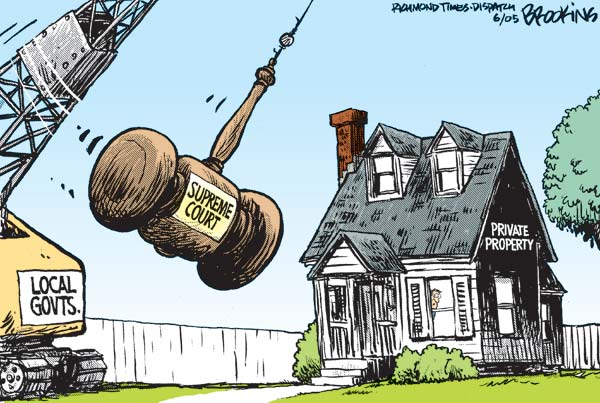Under the Ohio and U.S. Constitutions, the power of eminent domain can only be used for public purposes.
In this regard, Ohio Revised Code Section 163.021(A) provides that “[n]o agency shall appropriate real property except as necessary and for a public use. In any appropriation, the taking agency shall show by a preponderance of the evidence that the taking is necessary and for a public use.”
In Kelo v. City of New London, Conn., 545 U.S. 469, 125 S.Ct. 2655 (2005), the U.S. Supreme Court famously interpreted the public use requirement very expansively. The City of New London, Connecticut, had appropriated property for economic development purposes pursuant to an integrated development plan designed to revitalize the city’s economy through the creation of new jobs and increased tax revenue; the project involved a variety of commercial, residential, and recreational land uses. The Supreme Court held that the taking satisfied the “public use” requirement under the U.S. Constitution because the economic development at issue furthered a public purpose.
The Supreme Court of Ohio took a much narrower view of the public use requirement in Norwood v. Horney, 110 Ohio St.3d 353, 853 N.E.2d 1115 (2006), holding that, “[a]lthough economic factors may be considered in determining whether private property may be appropriated, the fact that the appropriation would provide an economic benefit to the government and community, standing alone, does not satisfy the public-use requirement of Section 19, Article I of the Ohio Constitution.”
Consistent with Norwood, Ohio Revised Code Section 163.01(H)(1) provides as follows:
(H)(1) “Public use” does not include any taking that is for conveyance to a private commercial enterprise, economic development, or solely for the purpose of increasing public revenue, unless the property is conveyed or leased to one of the following:
(a) A public utility, municipal power agency, or common carrier;
(b) A private entity that occupies a port authority transportation facility or an incidental area within a publicly owned and occupied project;
(c) A private entity when the agency that takes the property establishes by a preponderance of the evidence that the property is a blighted parcel or is included in a blighted area.
Sometimes, a proposed taking may benefit both public and private interests, and the question becomes whether the public use requirement is satisfied. In that regard, Ohio case law provides that, “[i]n order to justify the exercise of the power of eminent domain, the purpose to which the property taken is to be applied must be public, primarily public, and not primarily a private interest incidentally beneficial to the public.” Wagar v. City of Lakewood, 1914 WL 1225, 13 (Ohio Com.Pl. 1914) (citing Madisonville Traction Co. v. Mining Co., 196 U. S., 239). “The fact that private interests are also subserved, or even that such interests defray, in whole or in part, the expense of an improvement, does not take away the otherwise public nature of the improvement.” Weaver v. Pennsylvania-Ohio Power & Light Co., 10 F.2d 759, 762 (6th Cir. 1926).
The following uses have been declared public uses for eminent domain purposes in Ohio:
- Streets and highways – Pontiac Imp. Co. v. Board of Com’rs of Cleveland Metropolitan Park Dist., 104 Ohio St. 447, 135 N.E. 635 (1922)
- Off-street parking – Superior Laundry & Towel Supply Co. v. City of Cincinnati, 11 Ohio Op. 2d 350, 84 Ohio L. Abs. 172, 168 N.E.2d 445 (C.P. 1959)
- Slum and blight clearance and prevention – State ex rel. Bruestle v. Rich, 159 Ohio St. 13, 13, 110 N.E.2d 778, 780 (1953)
- Scenic use – Richley v. Crow, 43 Ohio Misc. 94, 72 Ohio Op. 2d 420, 334 N.E.2d 542 (C.P. 1975)
- Nuisance abatement – Lytle v. Potter, 480 F.Supp.2d 986, 990 n.2(N.D.Ohio,2006)
- utility facilities, roads, sewers, waterlines, public schools, public institutions of higher education, certain private institutions of higher education, public parks, government buildings, port authority transportation facilities, and projects by an agency that is a public utility – R.C. 163.01(H)(2)

